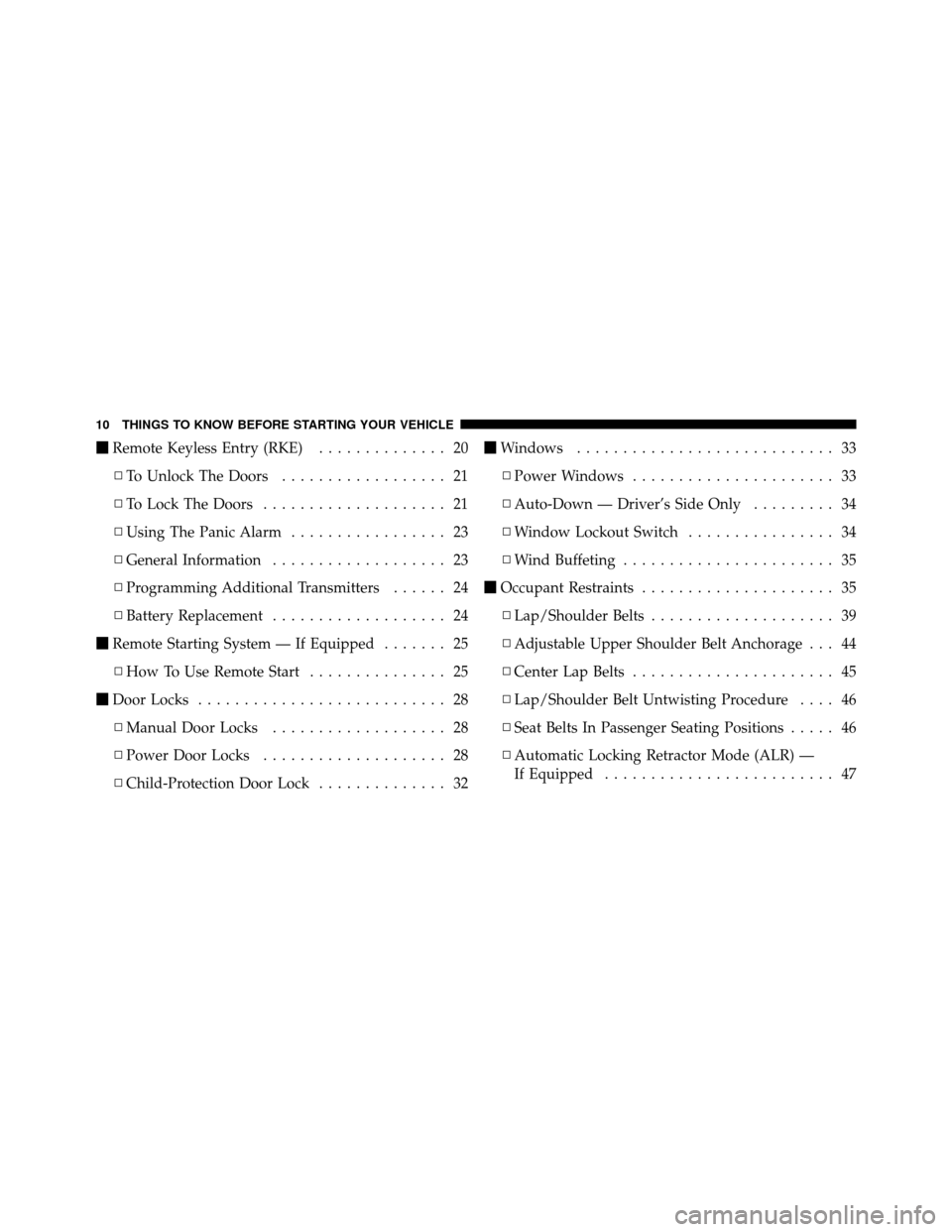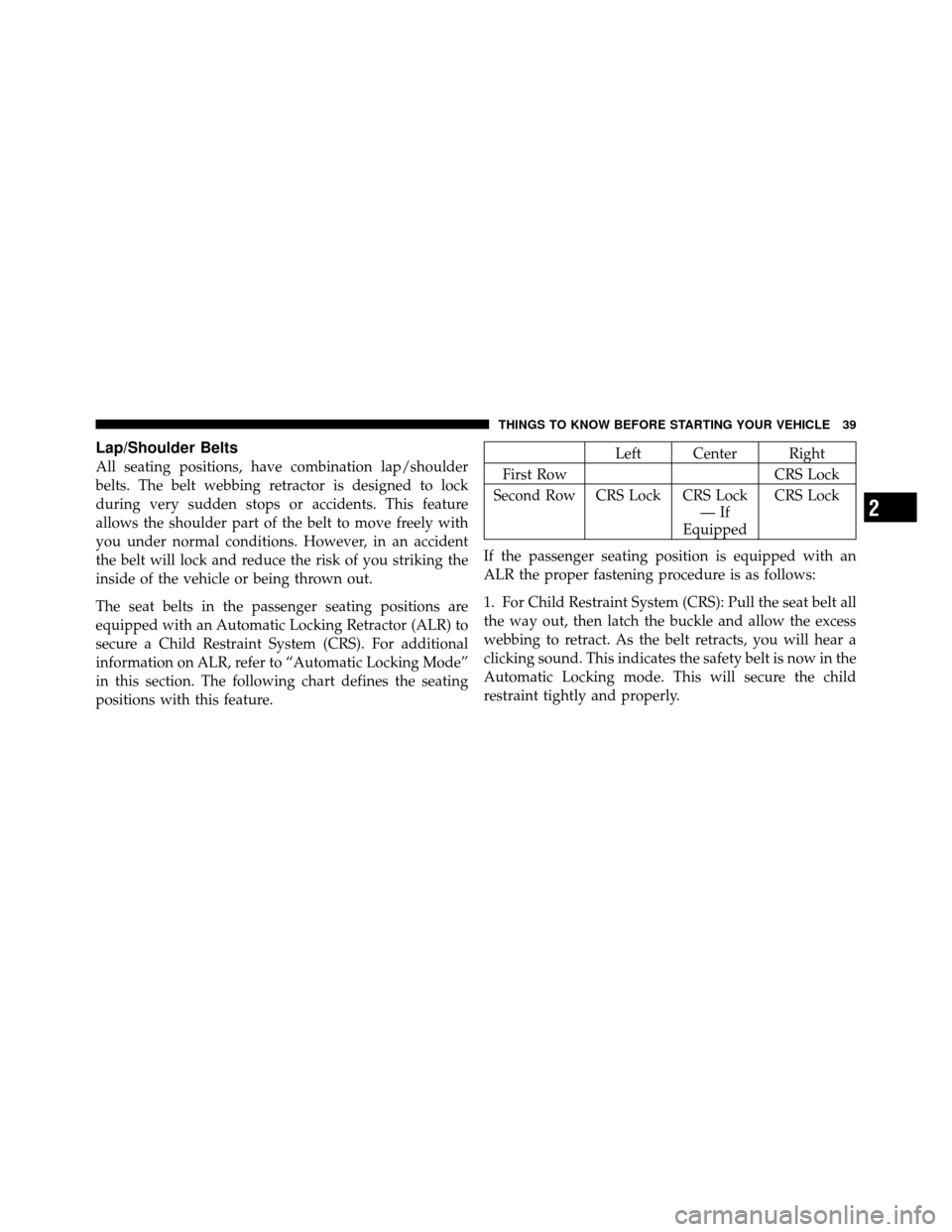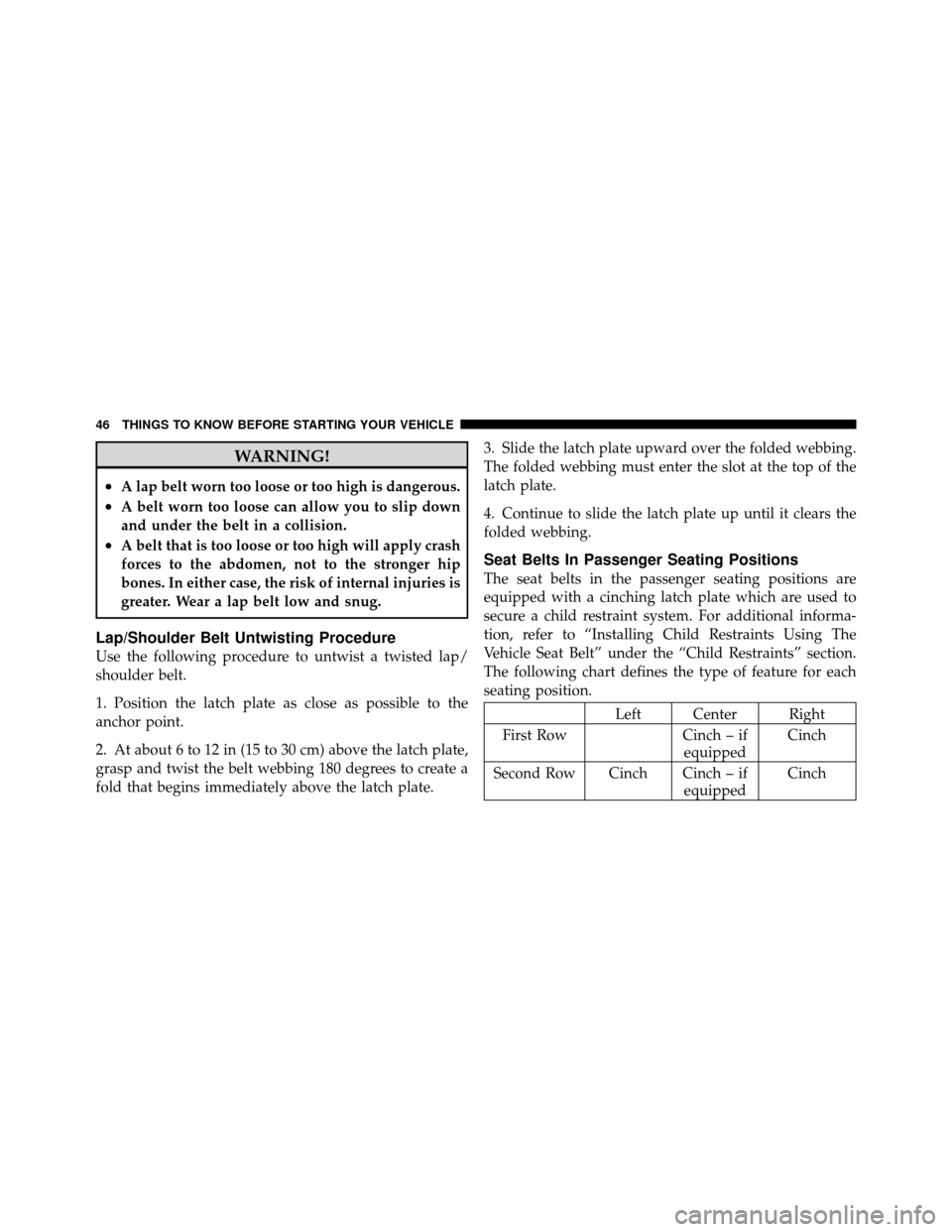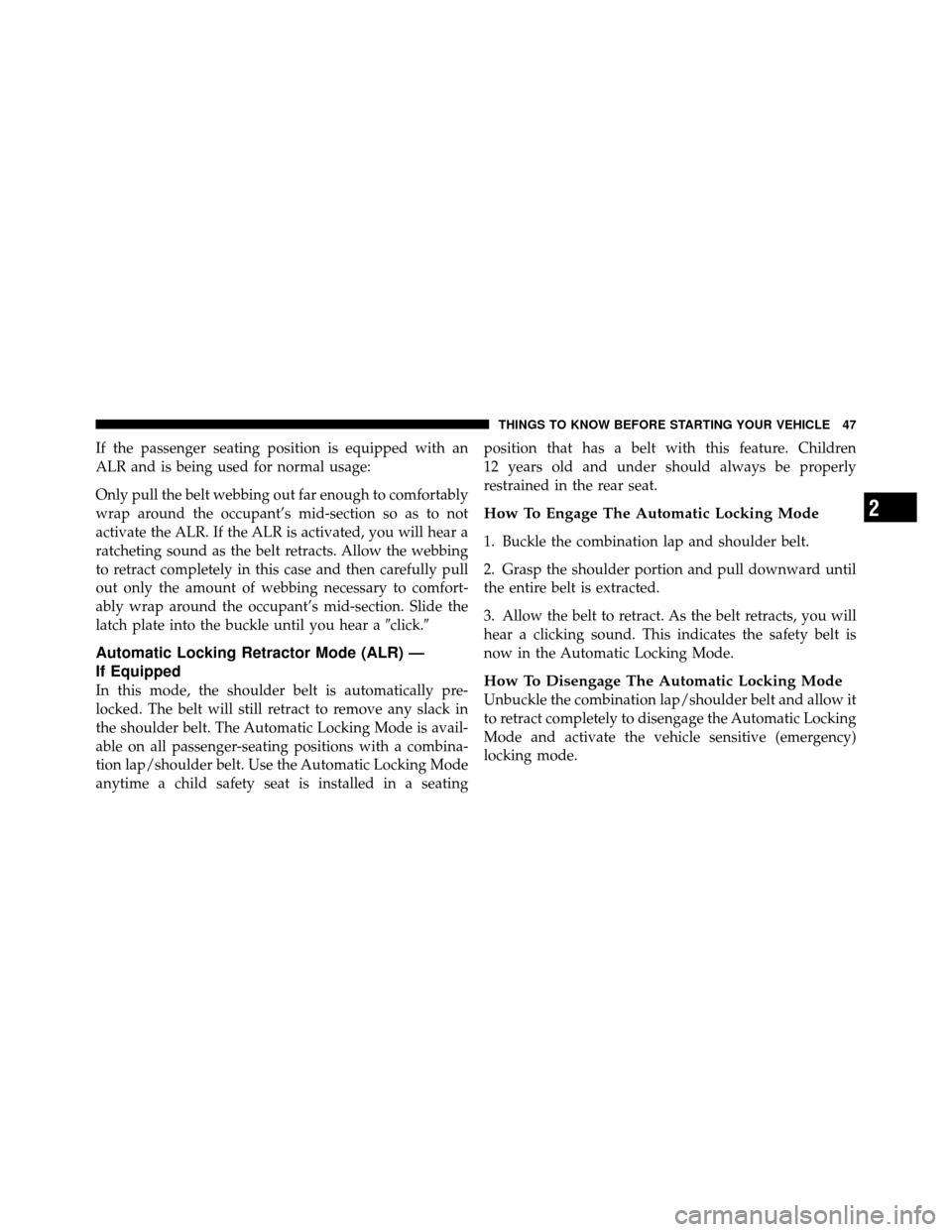Page 12 of 452

�Remote Keyless Entry (RKE) .............. 20
▫ To Unlock The Doors .................. 21
▫ To Lock The Doors .................... 21
▫ Using The Panic Alarm ................. 23
▫ General Information ................... 23
▫ Programming Additional Transmitters ...... 24
▫ Battery Replacement ................... 24
� Remote Starting System — If Equipped ....... 25
▫ How To Use Remote Start ............... 25
� Door Locks ........................... 28
▫ Manual Door Locks ................... 28
▫ Power Door Locks .................... 28
▫ Child-Protection Door Lock .............. 32�
Windows ............................ 33
▫ Power Windows ...................... 33
▫ Auto-Down — Driver’s Side Only ......... 34
▫ Window Lockout Switch ................ 34
▫ Wind Buffeting ....................... 35
� Occupant Restraints ..................... 35
▫ Lap/Shoulder Belts .................... 39
▫ Adjustable Upper Shoulder Belt Anchorage . . . 44
▫ Center Lap Belts ...................... 45
▫ Lap/Shoulder Belt Untwisting Procedure .... 46
▫ Seat Belts In Passenger Seating Positions ..... 46
▫ Automatic Locking Retractor Mode (ALR) —
If Equipped ......................... 47
10 THINGS TO KNOW BEFORE STARTING YOUR VEHICLE
Page 13 of 452
▫Seat Belt Pretensioners ................. 48
▫ Energy Management Feature ............. 48
▫ Enhanced Seat Belt Use Reminder System
(BeltAlert�) ......................... 49
▫ Seat Belts And Pregnant Women .......... 50
▫ Seat Belt Extender ..................... 51
▫ Supplemental Restraint System (SRS) – Air
Bags .............................. 51
▫ Advanced Front Air Bag Features .......... 53
▫ Air Bag Deployment Sensors And Controls . . . 55 ▫
Event Data Recorder (EDR) .............. 62
▫ Child Restraints ...................... 63
� Engine Break-In Recommendations .......... 75
� Safety Tips ........................... 76
▫ Transporting Passengers ................ 76
▫ Exhaust Gas ......................... 77
▫ Safety Checks You Should Make Inside The
Vehicle ............................. 78
▫ Periodic Safety Checks You Should Make
Outside The Vehicle ................... 80
2
THINGS TO KNOW BEFORE STARTING YOUR VEHICLE 11
Page 34 of 452
Child-Protection Door Lock
To provide a safer environment for children riding in the
rear seat, the rear doors of your vehicle have the child-
protection door lock system.To use the system, open each rear door, slide the lever up
to engage the locks, and down to disengage the child-
protection locks. When the system on a door is engaged,
that door can only be opened by using the outside door
handle, even if the inside door lock is in the unlocked
position.
Child-Protection Door Lock Location
Child Lock Control
32 THINGS TO KNOW BEFORE STARTING YOUR VEHICLE
Page 38 of 452

If you will be carrying children too small for adult-sized
seat belts, the seat belts or the Lower Anchors and Tether
for CHildren (LATCH) feature also can be used to hold
infant and child restraint systems. For more information
on LATCH, refer to Lower Anchors and Tether for
CHildren (LATCH).
NOTE:The Advanced Front Air Bags have a multistage
inflator design. This allows the air bag to have different
rates of inflation based on the severity and type of
collision.
Here are some simple steps you can take to minimize the
risk of harm from a deploying air bag:
1. Children 12 years old and under should always ride
buckled up in a rear seat.WARNING!
Infants in rear facing child restraints should never
ride in the front seat of a vehicle with a passenger
Advanced Front Air Bag. An air bag deployment can
cause severe injury or death to infants in that posi-
tion.
Children that are not big enough to wear the vehicle seat
belt properly (see section on Child Restraints) should be
secured in the rear seat in child restraints or belt-
positioning booster seats. Older children who do not use
child restraints or belt-positioning booster seats should
ride properly buckled up in the rear seat. Never allow
children to slide the shoulder belt behind them or under
their arm.
36 THINGS TO KNOW BEFORE STARTING YOUR VEHICLE
Page 39 of 452

If a child from 1 to 12 years old (not in a rear facing child
seat) must ride in the front passenger seat, move the seat
as far back as possible and use the proper child restraint.
(Refer to “Child Restraints”)
You should read the instructions provided with your
child restraint to make sure that you are using it properly.
2.All occupants should always wear their lap and
shoulder belts properly.
3. The driver and front passenger seats should be
moved back as far as practical to allow the Advanced
Front Air Bags room to inflate.
4. Do not lean against the door or window. If your
vehicle has side air bags, and deployment occurs, the
side air bags will inflate forcefully into the space
between you and the door. 5.
If the air bag system in this vehicle needs to be
modified to accommodate a disabled person, contact
the Customer Center. Phone numbers are provided
under �If You Need Assistance�.
WARNING!
•Relying on the air bags alone could lead to more
severe injuries in a collision. The air bags work
with your seat belt to restrain you properly. In
some collisions, the air bags won’t deploy at all.
Always wear your seat belts even though you have
air bags.
(Continued)
2
THINGS TO KNOW BEFORE STARTING YOUR VEHICLE 37
Page 41 of 452

Lap/Shoulder Belts
All seating positions, have combination lap/shoulder
belts. The belt webbing retractor is designed to lock
during very sudden stops or accidents. This feature
allows the shoulder part of the belt to move freely with
you under normal conditions. However, in an accident
the belt will lock and reduce the risk of you striking the
inside of the vehicle or being thrown out.
The seat belts in the passenger seating positions are
equipped with an Automatic Locking Retractor (ALR) to
secure a Child Restraint System (CRS). For additional
information on ALR, refer to “Automatic Locking Mode”
in this section. The following chart defines the seating
positions with this feature.Left Center Right
First Row CRS Lock
Second Row CRS Lock CRS Lock —If
Equipped CRS Lock
If the passenger seating position is equipped with an
ALR the proper fastening procedure is as follows:
1. For Child Restraint System (CRS): Pull the seat belt all
the way out, then latch the buckle and allow the excess
webbing to retract. As the belt retracts, you will hear a
clicking sound. This indicates the safety belt is now in the
Automatic Locking mode. This will secure the child
restraint tightly and properly.
2
THINGS TO KNOW BEFORE STARTING YOUR VEHICLE 39
Page 48 of 452

WARNING!
•A lap belt worn too loose or too high is dangerous.
•A belt worn too loose can allow you to slip down
and under the belt in a collision.
•A belt that is too loose or too high will apply crash
forces to the abdomen, not to the stronger hip
bones. In either case, the risk of internal injuries is
greater. Wear a lap belt low and snug.
Lap/Shoulder Belt Untwisting Procedure
Use the following procedure to untwist a twisted lap/
shoulder belt.
1. Position the latch plate as close as possible to the
anchor point.
2. At about 6 to 12 in (15 to 30 cm) above the latch plate,
grasp and twist the belt webbing 180 degrees to create a
fold that begins immediately above the latch plate.3. Slide the latch plate upward over the folded webbing.
The folded webbing must enter the slot at the top of the
latch plate.
4. Continue to slide the latch plate up until it clears the
folded webbing.
Seat Belts In Passenger Seating Positions
The seat belts in the passenger seating positions are
equipped with a cinching latch plate which are used to
secure a child restraint system. For additional informa-
tion, refer to “Installing Child Restraints Using The
Vehicle Seat Belt” under the “Child Restraints” section.
The following chart defines the type of feature for each
seating position.
Left Center Right
First Row Cinch – if equippedCinch
Second Row Cinch Cinch – if equippedCinch
46 THINGS TO KNOW BEFORE STARTING YOUR VEHICLE
Page 49 of 452

If the passenger seating position is equipped with an
ALR and is being used for normal usage:
Only pull the belt webbing out far enough to comfortably
wrap around the occupant’s mid-section so as to not
activate the ALR. If the ALR is activated, you will hear a
ratcheting sound as the belt retracts. Allow the webbing
to retract completely in this case and then carefully pull
out only the amount of webbing necessary to comfort-
ably wrap around the occupant’s mid-section. Slide the
latch plate into the buckle until you hear a�click.�
Automatic Locking Retractor Mode (ALR) —
If Equipped
In this mode, the shoulder belt is automatically pre-
locked. The belt will still retract to remove any slack in
the shoulder belt. The Automatic Locking Mode is avail-
able on all passenger-seating positions with a combina-
tion lap/shoulder belt. Use the Automatic Locking Mode
anytime a child safety seat is installed in a seating position that has a belt with this feature. Children
12 years old and under should always be properly
restrained in the rear seat.
How To Engage The Automatic Locking Mode
1. Buckle the combination lap and shoulder belt.
2. Grasp the shoulder portion and pull downward until
the entire belt is extracted.
3. Allow the belt to retract. As the belt retracts, you will
hear a clicking sound. This indicates the safety belt is
now in the Automatic Locking Mode.
How To Disengage The Automatic Locking Mode
Unbuckle the combination lap/shoulder belt and allow it
to retract completely to disengage the Automatic Locking
Mode and activate the vehicle sensitive (emergency)
locking mode.
2
THINGS TO KNOW BEFORE STARTING YOUR VEHICLE 47